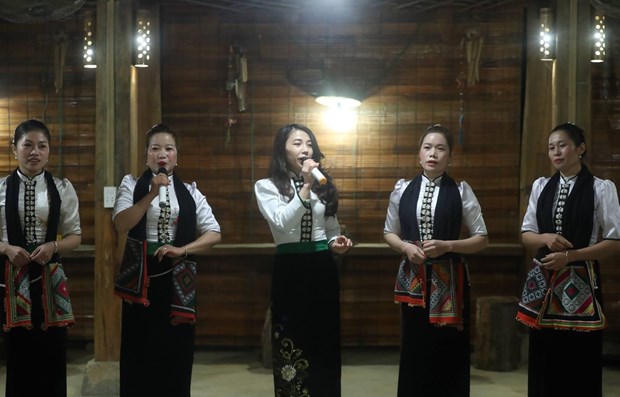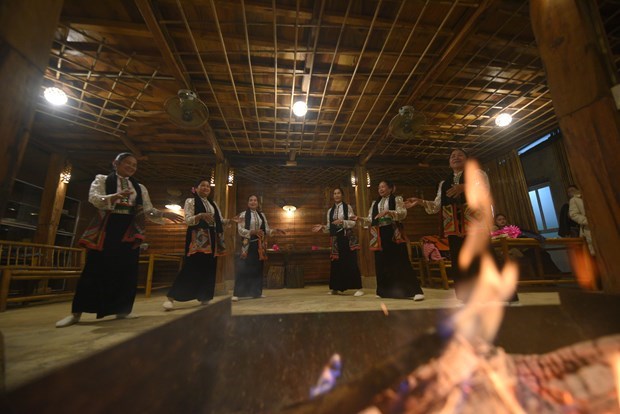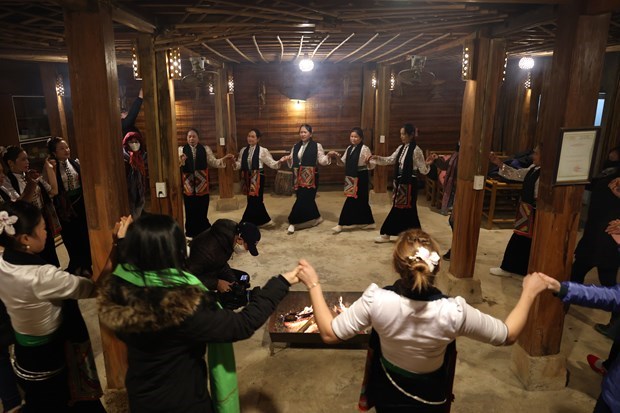Thai women promote national culture through Xoe dancing
 With lyrics and singing, Thai women in Vat village, Moc Chau district, Son La province, are contributing to preserving and popularising their culture (Photo: VietnamPlus)
With lyrics and singing, Thai women in Vat village, Moc Chau district, Son La province, are contributing to preserving and popularising their culture (Photo: VietnamPlus)Hanoi (VNA) - Thai women in Vat village in Son La province’s Moc Chau district are no longer just working in their homes or in the kitchen behind closed doors. They are confident to introduce their cultural identity through the intangible cultural identity of Xoe dancing.
After lunch, Ha Thi Bin, 65, and other women in Vat village, Muong Sang commune, Moc Chau district, the northwestern province of Son La, rehearse musical pieces to prepare for this evening’s performance.
“Specialty” of the Thai ethnic group
The art troupe is one of the "specialties" to attract tourists in Vat village. After a day of exploring tourist attractions such as Vat Hong pagoda, Ta Vang Hay stream, and Dai Yem waterfall, visitors gather around the fire to enjoy local cuisine and cultural exchanges with local Thai people in the evening.
Not only women and girls sing and dance well, the art troupe includes elderly ladies aged 50 and above who are extremely graceful and flexible in their traditional “Xoe” dances.
 Senior Thai women take lunch time to practise art performance (Photo: VietnamPlus)
Senior Thai women take lunch time to practise art performance (Photo: VietnamPlus)Ha Thi Bin was famous for beautiful dancing in the region when she was a young lady. She joined an art ensemble of Son La province, performing everywhere. She is now one of the core members of the art troupe. Community-based tourism has developed well over the years in Vat village in particular and Moc Chau district in general. Dance performances imbued with the Thai identity are some of the unique factors attracting tourists to the region.
Bin encouraged her daughter-in-law Vi Thi Thuong, and her grandchildren Lo Ngoc Muon (born in 1994) and Lo Ngoc Minh (born in 1997) to join the troupe. In addition to singing and dancing, Muon plays the role of MC for the village’s art programmes.
“Learning to sing traditional songs helps us preserve the identity of our own ethnic group, as well as promote typical features of Thai people in Moc Chau in particular and the Northwest in general,” Muon said.
 Lo Ngoc Muon, born in 1994, joins the troupe as a singer and a MC (Photo: VietnamPlus)
Lo Ngoc Muon, born in 1994, joins the troupe as a singer and a MC (Photo: VietnamPlus)
Confident to introduce their ethnic identity
The development of such art movements today are attributed to efforts of local officials in-charge and core people like Bin who have worked to encourage and persuade other locals to join.
Dinh Thi Huong from the culture and information division of Moc Chau district said the district participated in the Gender Responsive Equitable Agriculture and Tourism (GREAT) project funded by the Australian government in 2019. Vat village is one of the two community-based tourist sites in Moc Chau assisted by Action on Poverty (AOP) via a cooperation programme with the GREAT project.
 Thai women are singing and dancing in the firelight (Photo: VietnamPlus)
Thai women are singing and dancing in the firelight (Photo: VietnamPlus)In addition to setting up homestay groups, providing training for professional improvements on tourism-related skills, connecting travel agencies to develop markets and support to respond to COVID-19, the project focused on community-based tourism development in combination with preserving indigenous cultural values. The Vat village art troupe was established to realise the goal.
“Project officials collect songs and dances, and build art programmes. Training not only provides knowledge and skills but also disseminates information on gender equality, helping local women to be more confident in their endeavours,” Huong said.
Thai women in Vat village are no longer shyly hiding behind doors or working in the kitchen. They are in beautiful traditional dresses and are confident to introduce their cultural identity. The positive change is partially attributed to communication events on gender equality jointly held by GREAT and AOP over the past two years.
“At the end of a performance, we always invite tourists to join a Xoe dance. I can see the joy in their eyes as they are being invited to cultural activities of the local Thai people and this is also a chance for us to introduce our culture to tourists,” said Vi Thi Dinh, a member of the Vat village art troupe.
 Tourists joining locals in traditional xoe dance (Photo: VietnamPlus)
Tourists joining locals in traditional xoe dance (Photo: VietnamPlus)
The art of Xoe dance of the Thai ethnic minority people in Vietnam was listed as an Intangible Cultural Heritage of Humanity at the 16th session of the UNESCO's Intergovernmental Committee for the Safeguarding of the Intangible Cultural Heritage last December.
According to the UNESCO's Intergovernmental Committee, the art meets all of the five criteria set by UNESCO.
Xoe Thai is a unique type of traditional dance that is associated with and plays a significant role in the daily life of Thai ethnic communities in the northwest of Vietnam, especially in the provinces of Lai Chau, Dien Bien, Son La and Yen Bai. It is performed in various community activities from festivals to funeral rituals.
There are about 30 Xoe dances, which have been developed, protected and handed down through generations intact over hundreds of years, including Xoe quat (Xoe dance with a fan), Xoe khan (Xoe dance with a scarf), Xoe non (Xoe dance with a conical hat) and many others with contents reflecting community activities and expressing the Thai people’s emotion. With gentle and alluring rhythms, dancers usually form a circle around a festive flame and move to the sound of melodic traditional music./.











